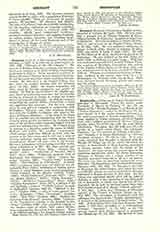

Sergiopolis, a titular see in Augusta Euphratensis, suffragan of Hierapolis. Under its native name Rhesapha, it figures in Ptolemy, V, xiv, 19; as Risapa in the “Tabula Peutinger.”; as Rosafa in the “Notitia dignitatum” (edited by Bocking, p. 88), the latter locates in it the equites promoti indigents, i.e. the natives promoted to Roman Knighthood. This name signifies in Arabic causeway, paved or flagged road, and a milliary mentioned by Sterrett (Corpus inscript. latin. III, 6719) who calls the town Strata Diocletiana. Procopius also (De bello pers., II, i, 6) speaks of a region called Strata (see Clermont-Ganneau, “La vole romaine de Palmyre Resapha” and “Resapha et la Strata Diocletiana” in “Recueil d’archeol. orientale”, IV, 69-74, 112). It is commonly admitted that Resapha is identical with the Reseph (IV Kings, xix, 12; Is., xxxvii, 12) which the envoys of Sennacherib to King Ezechias mentioned as having recently fallen into the hands of the Assyrians; the name occurs also several times in the cuneiform inscriptions under the forms Rasaappa, Rasappa, or Rasapi, and a certain number of its Assyrian governors from 839 to 737 B.C. are known. The town was then an important commercial center [Schrader, “Keilinschriften and Geschichtsforschung” (Giessen, 1878), 167, 199]. At Rosapha in the reign of Maximian the soldier Sergius, after whom the town was officially named, was martyred on October 7; Rosapha contained a Roman fortress at that time. Its first bishop was appointed shortly after 431 by John of Antioch, in spite of the opposition of the Metropolitan of Hierapolis, on whom that church had till then depended, for he had, he declared spent three hundred pounds of gold on it (Mansi, “Concil. collectio”, V, 915, 943). A little later’ Marianus of Rhosapha assisted at the Council of Antioch (Mansi, op. cit., VII, 325). The metropolis of Sergiopolis with five suffragan sees figures in the “Notitia episcopatuum” of Antioch in the sixth century (“Echos d’Orient”, X, 145). It had obtained this title from Emperor Anastasius I (491-518), according to a contemporary (Cramer, “Anecdota”, 11, 12, 109); at the fifth general council (553) Abraham signed as metropolitan (Mansi, op. cit., IX, 390). The favors of Ariastasius obtained for the town the name of Anastasiopolis, which it still retained at the beginning of the seventh century (Gelzer, “Georgii Cyprii Descriptio orbis romani”, 45). We may mention also Bishop Candidus, who, at the time of the siege of the town by Shah Chosroes, (543), ransomed 1200 captives for two hundred pounds of gold (Procopius, “De bello pers.” II, 5, 20), and the metropolitan Simeon in 1093 (“Echos d’Orient”, III, 238); this proves that Christianity continued to exist even under Mussulman domination. Procopius (“De wdificiis”, II, ix), describes at length the ramparts and buildings erected there by Justinian. The walls of Resapha which are still well preserved are over 1600 feet in length and about 1000 feet in width; round or square towers were erected about every hundred feet; there are also ruins of a church with three apses.
S. VAILHE

